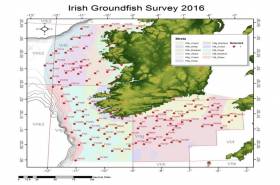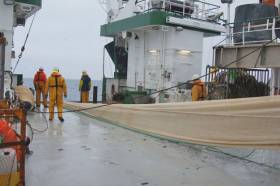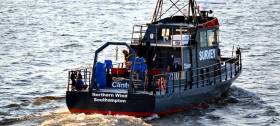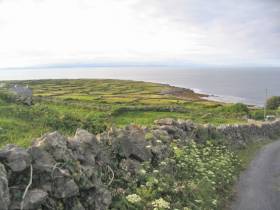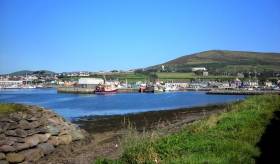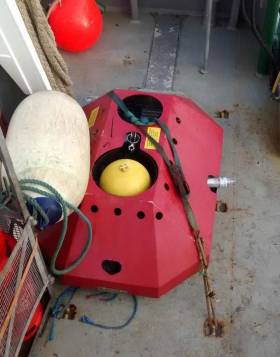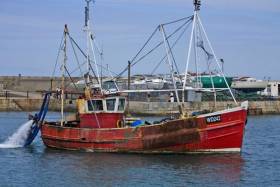Displaying items by tag: Marine Notice
Marine Notice: Annual Groundfish Survey Off South & West Coasts
#MarineNotice - The Marine Institute advises that the annual Irish Groundfish Survey (IGFS2016) will be carried out off the South and West coasts of Ireland between Monday 14 November and Sunday 18 December in fulfilment of Ireland’s Common Fisheries Policy obligations.
The IGFS is a demersal trawl survey consisting of a minimum of 125 fishing hauls of 30 minutes duration each. Fishing in 2016 will take place within a 2nm radius of the positions indicated in Marine Notice 44 of 2016, available to read or download HERE.
The survey will be conducted by the RV Celtic Explorer (Callsign EIGB), which will display all appropriate lights and signals during the survey and will also be listening on VHF Channel 16. The vessel will be towing a high headline GOV 36/47 demersal trawl during fishing operations.
The Marine Institute requests that commercial fishing and other marine operators keep a 2nm area around the tow points clear of any gear or apparatus during the survey period.
While there is no statutory provision for the loss of gear at sea, the Marine Institute will make every effort to avoid gear adequately marked according to legislation that may be encountered in the notified areas.
In the event that an operator has static gear or other obstructions within 2nm of the points listed above it is the responsibility of the owner to notify the survey managers or vessel directly. This should be communicated by identifying specifically which ‘Prime Station’ is of concern using the appendix and contact details provided in the Marine Notice. It is not required to provide positional details of commercial operations beyond 3-4nm of the survey points provided.
Specifics of any fishing gear or other obstructions that are known and cannot be kept clear of these survey haul locations can be notified using the contact details provided in the Marine Notice.
Annual Irish Groundfish Survey Now Under Way
#Fishing - The Marine Institute’s annual Irish Groundfish Survey (IGFS2016) began off the North West Coast on Sunday 25 September, continuing till Thursday 6 October, in fulfilment of Ireland’s Common Fisheries Policy obligations.
IGFS2016 is a demersal trawl survey consisting of a minimum of 45 fishing hauls each of 30 minutes’ duration. Fishing in 2016 is taking place within a two-nautical-mile radius of positions indicated in Marine Notice No 41 of 2016, available to read or download HERE.
The survey is being conducted by the RV Celtic Explorer (Callsign EIGB), which will display all appropriate lights and signals throughout and is also listening on VHF Channel 16.
The Celtic Explorer will be towing a high headline GOV 36/47 demersal trawl during fishing operations. The Marine Institute requests that commercial fishing and other marine operators keep a two-nautical-mile area around the tow points clear of any gear or apparatus during the survey period outlined above.
While there is no statutory provision for the loss of gear at sea, the Marine Institute will make every effort to avoid gear adequately marked according to legislation that may be encountered in the notified areas.
In the event that an operator has static gear or other obstructions within 2nmi of the haul points, it is the responsibility of the owner to notify the survey managers or vessel directly.
This should be communicated by identifying specifically which ‘Prime Station’ is of concern using the appendix and contact details provided.
It is not required to provide positional details of commercial operations beyond 3-4nmi of the survey points provided. Specifics of any fishing gear or other obstructions that are known and cannot be kept clear of these survey haul locations can be notified using the contact details provided in the Marine Notice.
Marine Notice: Seabed Mapping Off East Coast
#MarineNotice - All vessels on the East Coast, particularly those engaged in fishing, are requested to give a wide berth to a survey vessel carrying out seabed mapping operations on behalf of Clinton Marine Survey AB.
M/V Northern Wind (Callsign 2IOX2) began its survey on Thursday 22 September for a 15-day period, weather permitting. The vessel is displaying appropriate lights and markers, and is listening on VHF Channel 16 throughout the project.
The vessel may also be towing equipment including a sonar scanner, prompting the call for all other boats to keep a sharp lookout in relevant areas, the co-ordinates for which are detailed in Marine Notice No 40 of 2016, available to read or download HERE.
Aran Islands Cable Repairs Under Way Weeks After Power Outage
#MarineNotice - Repair works are currently ongoing on the Inis Mór–Inis Meáin cable weeks after a fault left the Aran Islands without power for a number of days.
The works, which began last Saturday 10 September and will continue for another week, weather permitting, are being carried out from an offshore platform manoeuvred with the assistance of workboats, as detailed in Marine Notice No 39 of 2016.
The tug ABBE is also operational in the vicinity of the platform during the repairs. Both platform and tug vessel maintain a listening watch on VHF Channels 12 and 16 for the duration of the project.
The platform is displaying day shapes and night lights as required in accordance with the International Regulations for Prevention of Collisions at Sea (COLREGS).
All vessels, particularly those engaged in fishing, are requested to give the area a wide berth and keep a sharp lookout in the relevant areas.
Another recent Marine Notice advises of a programme of maintenance and inspection on the Corrib subsea facilities from this week for the next three week.
Marine Notice No 38 of 2016 says the work will all take place within the 500m Safety Zone and will involve carrying out a programme of maintenance to investigate and repair some of
the subsea facilities as required.
The support vessel Olympic Ares will carry out the maintenance and inspection using a remote operated vehicle or ROV. The vessel will be listening on VHF Channel 16 throughout the project.
Marine Notice: Site Investigation Works At Dingle Fishery Harbour Centre
#MarineNotice - Site investigation works are being carried out at Dingle/An Daingean Fishery Harbour Centre in Co Kerry, according to the latest Marine Notice from the Department of Transport, Tourism and Sport.
The works involve the drilling of multiple boreholes at locations, subject to minor variations, as indicated by the co-ordinates and map included in Marine Notice No 37 of 2016, a PDF of which is available to read or download HERE.
Drilling was expected to begin yesterday (Monday 5 September) and will finish on or around Friday 28 October, weather permitting.
A jack-up barge will be moved to the various borehole locations by the tug Samson (Callsign ZQVL6) and will remain on site overnight during the operations.
All appropriate lights will be displayed by the barge at night. Radio navigation warnings will be transmitted on VHF Channel 16 throughout the works.
Marine Notice: Deployment Of Ocean-Bottom Seismometers
#MarineNotice - The latest Marine Notice from the Department of Transport, Tourism and Sport (DTTAS) advises that marine scientists from the Dublin Institute of Advanced Studies (DIAS) are deploying a tsunameter close to the new location of the M4 weather buoy off the Donegal coast.
In addition to the tsunameter, they will also deploy a sub-surface buoy with an acoustic Doppler current profiler (ADCP) mounted on it, as well as pressure sensors clamped to a moored string to measure pressure variations at depth. This system will be deployed in proximity to the tsunameter location but not too close to avoid tangling.
The tsunameter and system used for the ADCP and the pressure string sensors is scheduled to be be deployed imminently from the RV Celtic Voyager (Callsign: EIQN) at latitude 54°59.892 N, longitude 009°58.14 W, at a depth of 119m adjacent to M4 weather buoy.
As this is sensitive scientific equipment, it is requested that fisherman and marine operators engaged in such activities as bottom trawling or laying of static gear avoid the locations concerned to avoid damaging the equipment or damaging fishing gear.
Watch Your Bilge Spaces, Fishing Boat Operators Warned
#Fishing - The latest Marine Notice from the Department of Transport, Tourism and Sport reminds fishing vessel operators to monitor their bilge spaces prior, during and after voyages.
It is also essential that bilge alarms are tested regularly, to determine that both the audible and visible alarms are working.
In addition, it is good practice to regularly inspect bilge suction strainers to ensure they are clean and ready for use.
The notice is prompted by the recommendation made in last year's report by the Marine Casualty Investigation Board into the sinking of the FV Napier off the Saltee Islands on 30 January 2014.
As previously reported on Afloat.ie, the Kilmore Quay lifeboat launched to the rescue of two fishermen on board the small lobster boat as it sank off the Co Wexford islands.
The official MCIB report into the incident was unable to determine the exact cause of water flooding the boat's bilge and engine area as it was not recovered from the sea bed, though it is presumed to be a serious failure of the seawater cooling system.
Marine Notice: Dregding Works At Rossaveal Fishery Harbour Centre
#MarineNotice - The latest Marine Notice from the Department of Transport, Tourism and Sport (DTTAS) advises of the of the dredging of soft material and disposal at sea, drilling and blasting and removal of bedrock, construction of breakwater and revetment and other associated works at Rossaveal Fishery Harbour Centre.
The works by Cronin Millar Consulting Engineers at the Galway Bay fishing harbour will commence on tomorrow Monday 22 August and continue till January 2017.
The first phase of the works, commencing tomorrow, will comprise the construction of a temporary causeway on the foreshore within the dredge site to facilitate excavation of seabed and disposal at a licensed on-shore site.
The second phase of the works, will commence in the coming weeks and will involve a jack-up barge, floating barge, safety boat, personnel boat, split barge and work boats. This will be advised under a second marine notice.
Maps and co-ordinates of the work areas are detailed in Marine Notice No 34 of 2016, a PDF of which is available to read or download HERE.
Other recent Marine Notices cover outfall pipeline remedial works ongoing at the Corrib gas field, and information on the carriage of inflatable life rafts on small fishing vessels under 15m.
#MarineNotice - Shell E&P Ireland were scheduled to commence flowline installation works between two existing subsea wells at the Corrib gas field this week.
This work will be followed by placement of rock protection along the length of the exposed flowline between the two wells.
There may also be some additional rock placement along the pipeline corridor from the offshore field to the landfall at Broadhaven Bay.
The works, due to commence during this last week of July, are expected run for 30 to 40 days.
The first phase of works will all take place within the 500m Safety Zone surrounding the wells P2 and P5, and along the corridor between P2 and P5.
Carried out by the Skandi Neptune (callsign 2HMG8), the work involves the lay of a new flowline between the two wells followed by connection at each end and pressure testing.
Final seabed connections will be completed on the existing seabed control umbilical followed by the commissioning of the P2 well control system.
This work is expected to be completed by mid August, after whic the Nordnes (callsign PHOG) will commence the second-phase rock placements.
The guard vessel Glomar Arctic (callsign H09083) will be on location in the Corrib Field for the duration of the project. Radio warnings will be given to all marine traffic in the
immediate area. All the vessels will be listening on VHF Channel 16 throughout the project.
Details of co-ordinates of the relevant work areas are included in Marine Notice No 29 of 2016, a PDF of which is available to read or download HERE.
Meanwhile, TechWorks Marine were scheduled to deploy two temporary buoys in the Shannon Estuary on Friday 29 July.
The buoys are required for the placement of turbidity sensors before and during a dredge campaign, and will be in place for the next four weeks.
These data buoys, deployed on a single point mooring, are 1.2m wide, are yellow in colour and have a yellow navigation light with a 2nm range, with five flashes every 20 seconds.
Co-ordinates are included in Marine Notice No 30 of 2016, a PDF of which is available to read or download HERE.
#MarineNotice - CGG Services SA is scheduled to carry out an extensive multi-client 3D seismic survey in the Porcupine Basin off the southwest coast of Ireland.
The seismic survey, named Ireland 2016 MC3D MSS, is further sub-divided into two areas called Area A (in the western area) and Area B (in the southern area).
CGG will start the seismic survey in Area A. The duration of survey in this area will be 25 days. Following the completion of survey in Area A, CGG will start acquiring Area B. This is expected to start late July 2016.
Survey Area A will cover 1,012 sq km and is anticipated to commence in the third week of June 2016. The expected duration is approximately 30 days, subject to weather conditions. Survey Area B will cover 4,078 sq km and is anticipated to commence in the third week of July 2016. The expected duration is approximately 65 days, again subject to weather.
The survey vessel RV Oceanic Endeavour (Callsign 3EJQ7) is scheduled to carry out the work. The vessel will tow 14 separate 8,100m-long solid streamers, with a separation of 100m and at depth of 12m below the surface of the water.
Active radar transponders and flashing navigation lights will be on the outer streamer tail buoys. The seismic vessel and equipment will traverse along pre-determined lines NW-SE across the operations area at a speed of approximately 4.5 knots.
The seismic vessel will be accompanied by support vessel MV Bourbon Grebe (Callsign 5BAT4) and guard vessel MV Stormhav (Callsign V4VD2).
Fishery liaison officers (FLOs) will be on board the RV Oceanic Endeavour to ensure communications with fishermen are clear and timely. All vessels engaged on this survey will be listening on VHF Channel 16 at all times throughout the project.
All other vessels, particularly those engaged in fishing, are requested to give the RV Oceanic Endeavour and her towed equipment a wide berth and keep a sharp lookout in the relevant areas.
Full details of the survey area are included in Marine Notice No 28 of 2016, a PDF of which is available to read or download HERE.

